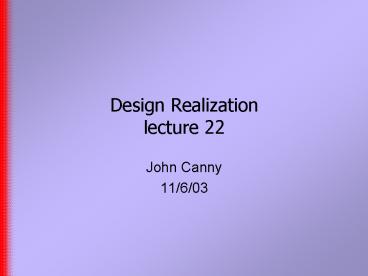Design Realization lecture 22 - PowerPoint PPT Presentation
1 / 17
Title:
Design Realization lecture 22
Description:
There is a companion to Matlab/Simulink called 'real-time workshop' (RTW). RTW automatically generates C code to run a Simulink model. ... – PowerPoint PPT presentation
Number of Views:68
Avg rating:3.0/5.0
Title: Design Realization lecture 22
1
Design Realization lecture 22
- John Canny
- 11/6/03
2
Last time
- Some physics
- Bending and stretching
- Construction methods
- Molding
- Welding
- Structural components
- Modular systems
3
This time
- Circuit design critique
- Control principles
- Simulation Matlab/Simulink
4
Feedback Control
- Often we want to move a system in a particular
way, by controlling a parameter such as - Position control
- Speed control
- Force control
- Feedback control uses sensor(s) to measure this
parameter and make corrections. - Feedback must be applied with care to avoid
ever-increasing corrections (instability).
5
Feedback Control
- Naively, we want to do something like this
V
Amplifier
Input(voltagerepresentingdesired angle)
Potentiometer on shaft(angle sensor)
Motor
6
Feedback Control
- Any difference between input and measured shaft
angle will be amplified, moving the motor. - If the direction is correct, the motor will
reduce the difference. With high gain, the error
? 0.
V
Amplifier
Input
Potentiometer on shaft(angle sensor)
Motor
7
Simulink Models
- Tools like Matlab/Simulink allow us to design and
test controllers before building them. - Here is the controller just shown in Simulink
Voltage
angle
8
Feedback Instability
- Problem the amplifier has delay, the motor has
inertia, keeps moving even after error ? 0. - If gain is too high, it will overshoot, ring or
possibly oscillate.
9
PD Stabilizing Controller
- The simplest way to control feedback is with a
PD (Proportional Derivative) controller. - A multiple of the derivative of the output is
subtracted from the amplifier input.
10
PD Stabilization
- Why does derivative feedback stabilize the
system? - Derivative feedback simulates a damper.
- Motion in a fluid creates viscous drag (F ? -v).
- Viscous drag quickly robs the system of energy.
11
PID Control
- Sometimes there is a residual error between
desired and actual output (not for DC motors). - Computing the integral of the difference signal
will reduce it to zero in the steady state.
12
PID Tracking Controller
- All three terms P,I,D are computed on the
difference signal
PID controller
13
Implementing PID Controllers
- Normally, the controller CPU is running at fixed
discrete time steps. - Derivates can be computed by differencing
consecutive samples, integrals by summing
samples. - This approach introduces delays and can cause
problems at high frequency. - Make sure that amplifiers roll off at high
frequency use a low-pass amplifier.
14
Discrete lowpass amplifier
- Input is (x1,,xn), output is (y1,,yn)
- yk a yk-1 (1-a)b xk a, b
constants, a lt 1. - If x 0, y non-zero, then the amplifier outputs
a decreasing geometric sequence, which is a
discrete approximation to exponential decay. - It simulates a simple RC low-pass circuit.
15
Discrete lowpass amplifier
- The amplifiers DC Gain is b
- Corner frequency ?c (- ln a)/t 2?fcwhere t
is the discrete step time.
16
Automatic code generation
- There is a companion to Matlab/Simulink called
real-time workshop (RTW). - RTW automatically generates C code to run a
Simulink model. It can handle new user-defined
blocks (e.g. for sensor input or motor output). - This code can be compiled and run on the control
processor.
17
Automatic code generation
- RTW code generation includes scheduling and
event-handling and allows blocks to run at
different rates. - It also allows complicated models that may not
run correctly with a simple discrete-step
approximation.































